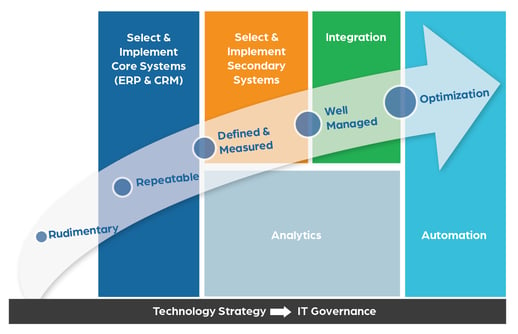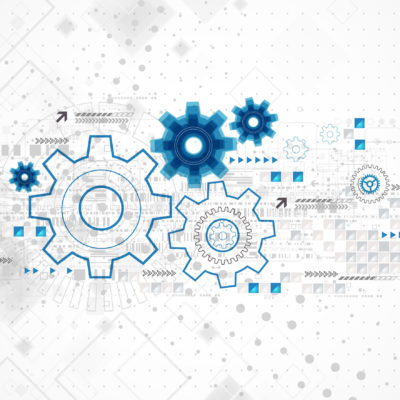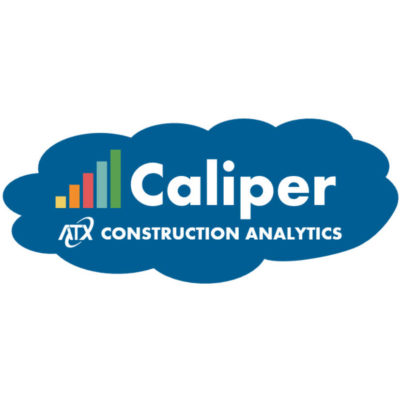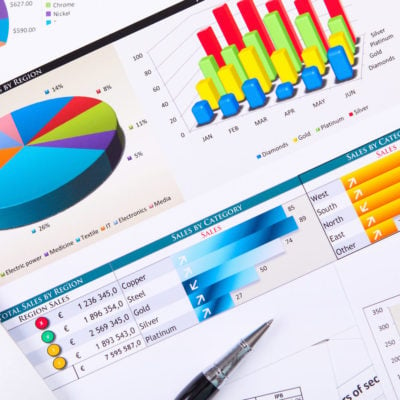Author: Mark DiGiovanni
Does managing day-to-day operations or gaining value from all of the data you collect create frustration for your leadership team? The cause could be that the maturity of your business operations has jumped ahead of your technology maturity. Many companies that experience rapid growth discover they simply don’t have the technology tools to run things as efficiently as they used to.
This often occurs as companies grow quickly in the areas of output capacity, revenue generation, and/or headcount. To keep up, they need to deploy more sophisticated accounting solutions and eventually evolve to a more robust ERP platform.
From there, efficiently managing continued growth requires integration of ERP with other enterprise systems and eventually business intelligence. Only then can managers effectively access and leverage the key performance indicators that enable strong business decision-making.
The final step—based on today’s available technologies—involves fully optimizing business processes. This is where advanced technologies such as artificial intelligence, machine learning, and robotic process automation come into play.
Assessing Your Technology Maturity
So perhaps it’s time to take a step back and assess the technology maturity of your company. Here are the five stages that companies typically go through in order to keep executing business processes efficiently as they grow:
- Stage 1 (Rudimentary) consists of very few digital processes. The company executes functions based on individual effort. Accounting and management are supported by simple technology solutions such as Excel spreadsheets and online banking accounts. These are usually point solutions deployed out of necessity. A basic accounting system such as QuickBooks may also exist but limited controls over data exist.
- Stage 2 (Repeatable) involves basic processes that can be repeated for similar tasks, such as the deployment of a multi-user accounting solution to manage common transactional processes along with the deployment of a CRM platform for pipeline management. Managers can now run reports to analyze revenue and spending. The business may also deploy isolated point solutions to manage marketing, production, and customer service.
- Stage 3 (Defined and Measured) kicks off the phase to precisely define standardized and consistent processes. Security and controls is a strong focus along with the development of standard operating procedures. This stage also integrates accounting with other enterprise solutions such as CRM, service, manufacturing, and warehouse operations. This may require a leap to a more scalable ERP platform, such as Microsoft Dynamics or NetSuite.
- Stage 4 (Well Managed) brings in strategic analysis powered by business intelligence, where the ERP platform and other enterprise applications feed into an analytics platform such as Tableau or Power BI to monitor business performance and quantify key performance indicators. The business now has real-time access to vital information to measure the quality of processes and to speed up the decision-making processes.
- Stage 5 (Optimization) sees the introduction of the next level of analytics, which may include artificial intelligence or machine learning along with the deployment of workflow solutions including robotic process automation. This enables operations to run faster and more efficiently so sales can close sooner, customers receive products faster, and cash flow accelerates with appropriate tools in place to monitor performance.
It’s common for companies to want to skip one or more of the stages. They see the magic that other companies can wield using AI and think, “We can do that too!” But you can’t get to Stage 5 until you complete all the steps before and in the proper order as the organization and it’s processes often need to mature to these advanced levels.
Effectively leveraging technology requires a certain level of patience, and realizing, like a farmer, that you can’t just jump ahead to the harvest. You have to carefully plan and sow the seeds, and then nurture your technology as you progress from Stage 1 through Stage 4, in order. Then, you will be ready for Stage 5.
Full Technology Maturity Not Necessarily Required
Also, consider that not every business needs to evolve through all five stages in rapid succession. Depending on your business model and the size of your company, Stage 3 or Stage 4 might be the furthest you need to travel in the current stage of your business.
That’s why it’s important to align your business road map to your technology road map. Making sure the two stay in sync will allow you to run your business efficiently over the short term. You can also project what’s coming in the future and determine if and when it will be time to take the next step.
To find out where your company stands today across the technology maturity spectrum contact us for assistance in comparing your current technology maturity to your business operations maturity. You can also reach out to me directly at mark.digiovanni@atxadvisory.com




